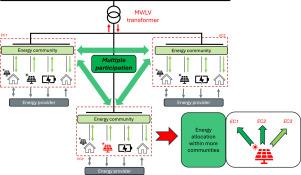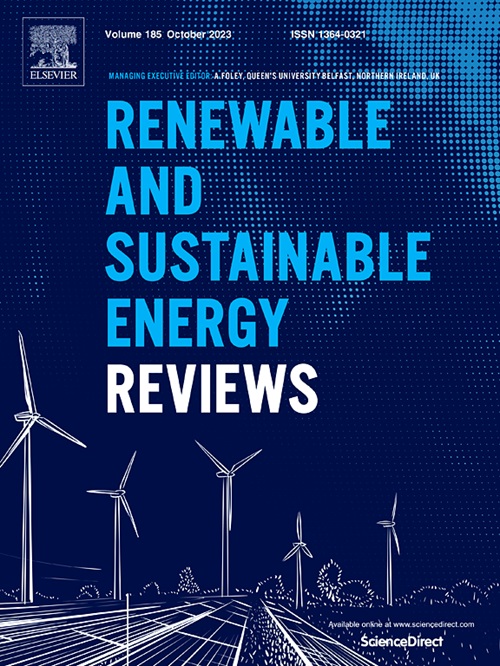通过加强多方参与,实现能源社区的电网友好型优化
IF 16.3
1区 工程技术
Q1 ENERGY & FUELS
引用次数: 0
摘要
能源社区的设计目的是促进可持续发展,其形式包括改善能源获取、可负担得起的能源获取、可持续发电和社会包容。随着其立法背景的不断发展,未来的升级有望增加这些新型能源概念所带来的益处。在奥地利,从 2024 年起,将有可能同时参与多个能源社区;因此,有必要评估参与者和现有电网的潜在利益。因此,本研究提出了一个优化模型,用于分配最初属于不同社区的每个参与者、发电装置和储能装置的需求和生产,这些社区在同一配电变压器下实施,并进行多重参与。能源和电网相关成本均最小化,并将基准独立能源社区案例与新型多重参与案例进行比较。通过敏感性分析,评估了参与者对提供灵活性(以甩负荷的形式)的接受程度的影响。结果表明,与独立案例相比,多重参与可在变压器层面额外减少排放量(3.5%)、成本(高达 10%)和峰值需求(高达 29%)。然而,与发电量份额较低的社区相比,发电量份额较高的社区可能会处于不利地位。储能也有助于降低成本和峰值需求,但代价是老化速度加快,而且独立参与和多方参与情况下的差异相对较小。本文章由计算机程序翻译,如有差异,请以英文原文为准。

Grid-friendly optimization of energy communities through enhanced multiple participation
Energy communities have been designed to promote sustainable development in the form of improved and affordable energy access, sustainable generation, and social inclusion. As their legislative background continues to evolve, future upgrades are expected to increase the benefits that these novel energy concepts offer. In Austria, from 2024 onwards, it will be possible to participate in more than one energy community at the same time; as such, it is necessary to evaluate the potential benefits for participants and the existing electricity grid. Thus, in this study, an optimization model is proposed to allocate the demand and production of each participant, generation unit, and storage initially belonging to different communities that are implemented under the same distribution transformer and engage in multiple participation. Both energy- and grid-related costs are minimized, and the benchmark independent energy community case is compared with the novel multiple participation. The influence of participants’ acceptance on providing flexibility (in the form of load shedding) is assessed through sensitivity analysis. The results show that, compared to the independent case, multiple participation could provide additional reductions in terms of emissions (3.5%), costs (up to 10%), and peak demand (up to 29%) at the transformer level. However, communities with higher generation shares could be individually disadvantaged compared to those with lower generation shares. Storage could also assist in reducing costs and peak demand, but at the cost of faster aging and with relatively small differences between the independent and multiple participation cases.
求助全文
通过发布文献求助,成功后即可免费获取论文全文。
去求助
来源期刊

Renewable and Sustainable Energy Reviews
工程技术-能源与燃料
CiteScore
31.20
自引率
5.70%
发文量
1055
审稿时长
62 days
期刊介绍:
The mission of Renewable and Sustainable Energy Reviews is to disseminate the most compelling and pertinent critical insights in renewable and sustainable energy, fostering collaboration among the research community, private sector, and policy and decision makers. The journal aims to exchange challenges, solutions, innovative concepts, and technologies, contributing to sustainable development, the transition to a low-carbon future, and the attainment of emissions targets outlined by the United Nations Framework Convention on Climate Change.
Renewable and Sustainable Energy Reviews publishes a diverse range of content, including review papers, original research, case studies, and analyses of new technologies, all featuring a substantial review component such as critique, comparison, or analysis. Introducing a distinctive paper type, Expert Insights, the journal presents commissioned mini-reviews authored by field leaders, addressing topics of significant interest. Case studies undergo consideration only if they showcase the work's applicability to other regions or contribute valuable insights to the broader field of renewable and sustainable energy. Notably, a bibliographic or literature review lacking critical analysis is deemed unsuitable for publication.
 求助内容:
求助内容: 应助结果提醒方式:
应助结果提醒方式:


